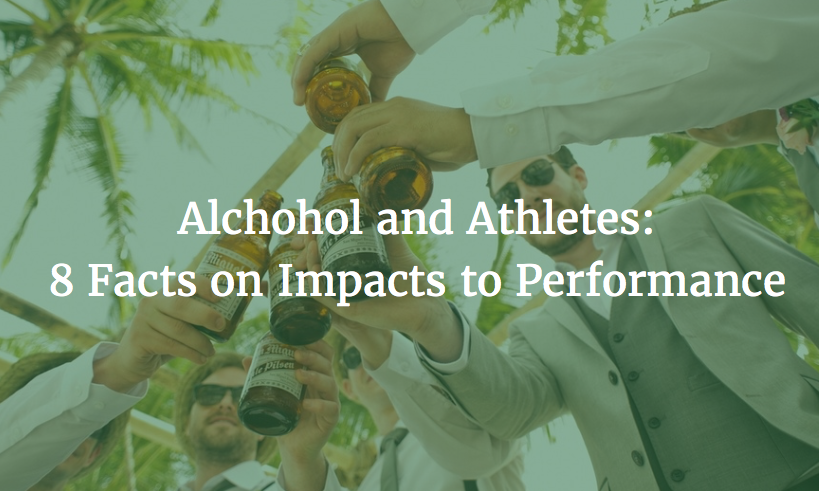 Athletes are competitive. Unfortunately, too many competitive athletes are also competitive drinkers, not to be outdone by their teammates. Ask any coach or college athletic director, and you’ll hear concern about alcohol and athletes—a dangerous duo, especially among team sports. Excessive alcohol intake is associated with injuries, poor grades in school, arguments, sexual abuse, loss of memory, driving under the influence, and trouble with the law—to say nothing of vomiting, hangovers and poor athletic performance.
Athletes are competitive. Unfortunately, too many competitive athletes are also competitive drinkers, not to be outdone by their teammates. Ask any coach or college athletic director, and you’ll hear concern about alcohol and athletes—a dangerous duo, especially among team sports. Excessive alcohol intake is associated with injuries, poor grades in school, arguments, sexual abuse, loss of memory, driving under the influence, and trouble with the law—to say nothing of vomiting, hangovers and poor athletic performance.
Yet, celebrating wins with alcohol is perceived as the norm. Whether athletes feel pressure to celebrate with alcohol or they enjoy drinking, research shows college athletes binge-drink more than non-athletes, and serious recreational runners drink more than their sedentary counterparts. Unfortunately, alcohol is a highly addictive substance and is the most abused drug in the United States.
How to address the problem of alcohol abuse?
To address alcohol abuse among student-athletes, many college campuses are educating students about social norms—the beliefs about what is normal and expected in social situations. For example, despite popular belief, everyone does not drink nor do most students get drunk all the time.
| Calories from Alcohol Add-up Quickly | ||
| Common Drinks | Amount (ounces) | Calories |
| Pina Colada | 6 | 380 |
| Mai Tai | 4.5 | 350 |
| Margarita | 8 | 280 |
| Red Bull & Vodka | 10 | 210 |
| Rum & Coke | 8 | 185 |
| Beer | 12 | 140 |
| Wine | 5 | 120 |
| Lite beer | 12 | 110 |
| One shot 80 proof alcohol | 1.5 | 100 |
A survey at Southern Methodist University asked these questions to students on a Friday about alcohol use on the previous night:
Did you drink last night?
Did you get drunk last night?
What percentage of SMU students do you think drank last night?
What percentage of SMU students do you think got drunk last night?
The answers showed major misperceptions about alcohol norms:
- Only 20% of students surveyed reported drinking the previous night, yet they believed that over half drank.
- Only 8% reported getting drunk, yet they believed at least one-third got drunk.
- Of students who drank, most reported consuming only a few drinks per week. Yet they believed most students were drinking 10 to 15 drinks per week.
- 35% reported abstaining from alcohol, but very few believed that many of their peers were non-drinkers.
At Dartmouth College, a typical social norms statement might be 74% of Dartmouth drinkers have zero to 4 drinks on the average Friday night. That means, binge-drinking is NOT the norm! With ongoing social norm education, students will hopefully change their drinking practices. Given that athletes are often role models, reduced alcohol use among athletes can potentially have a positive widespread social benefit.
Minimizing negative consequences
If alcohol has a big role in your sports diet, take note:
• Alcohol is a depressant. Apart from killing pain, it offers no performance edge. You can’t be sharp, quick, and drunk. Pre-exercise alcohol hurts reaction time, accuracy, balance, eye-hand coordination, and endurance.
• Alcohol has a diuretic effect; the more you drink, the more fluids you lose. Alcohol-free beer rehydrates, but regular beer sends you running to the bathroom. This is bad for recovery, bad for the next exercise bout.
• Alcohol stimulates the appetite. People who drink moderately tend to consume alcohol calories on top of their regular caloric intake. These excess calories accumulate as body fat. If you want to maintain a lean machine, abstaining is more slimming that imbibing.
• Your liver breaks down alcohol at a fixed rate: about one can of beer or 4 ounces of wine per hour. Exercise does not hasten the process, nor does coffee. Caffeine just makes you a wide-awake drunk.
• Alcohol is a poor source of carbohydrates. You can get loaded with beer, but your muscles will not get carbo-loaded. A 12-ounce can of beer has only 14 grams of carbohydrate, as compared to 40 grams in a can of soda. Eat pretzels, thick-crust pizza or other carbs along with the beer.
• Alcohol on an empty stomach quickly leads to a drunken stupor. Maybe you could enjoy the natural high of exercise instead of getting brought down by a few post-exercise beers?
• Late night partying that contributes to sleep deprivation (as well as a hangover) can easily ruin the next days’ performance.
• Drinks that contain congeners—whiskey, cognac, and red wine—are more likely to cause hangovers than other alcoholic beverages. The best hangover remedy is to not drink excessively in the first place. But if you have a hangover, drink a salted fluid with carbs, such as a sports drink or chicken noodle soup.
Is there any good news about alcohol?
Yes! In moderation, alcohol can have health benefits. Red wine, for example, contains health-protective phytochemicals that can reduce the risk of heart disease. A drink before a meal might improve digestion. A drink with friends brings social pleasure.
The key word is moderation. Moderation means two drinks per day for men and one for women. To help enforce moderation, first quench your thirst with a non-alcoholic beverage, and then, if desired, choose the alcohol-laden option.
Sports nutritionist Nancy Clark MS RD CSSD has a private practice in the Boston-area (Newton; 617-795-1875), where she helps both fitness exercisers and competitive athletes create winning food plans. Her best-selling Sports Nutrition Guidebook, and food guides for marathoners, cyclists and soccer are available at www.nancyclarkrd.com. For workshops, see www.NutritionSportsExerciseCEUs.com.






